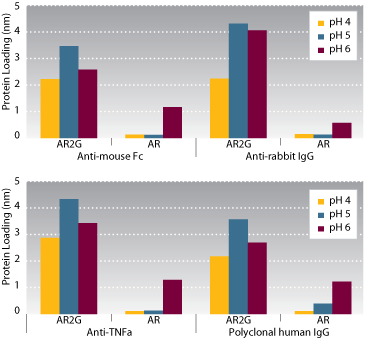EDC/Sulfo-NHS Based Immobilization for Kinetic Characterization of Primary Amine Containing Biomolecules
The AR2G biosensor is a newly engineered biocompatible surface matrix that delivers enhanced performance for kinetic assays compared to the original Amine Reactive (AR) biosensor for most proteins (Figure 1). AR2G routinely achieves greater signal intensity than the AR biosensor during both the loading (immobilization of ligand) and association (detection of analyte) steps of an assay while delivering the same reliable kinetic values. Evaluation of four antibody proteins demonstrated an increase in the intensity of the loading signal by an average of 4-fold with one example extending to 7.5-fold (Figure 1). A screen of several buffer systems determined that the AR2G chemistry is highly compatible with acetate buffer, which is both commonly available and cost-effective. A decrease in non-specific binding events to the AR2G surface compared to AR has also been demonstrated.
Learn more:
Download
.
Download
.
Key Features
- Rapid immobilization of proteins and peptides
- Kinetic analysis of ligand-analyte pairs
- Rapid assay development
- Second-generation amine reactive detection surface (AR2G)

Figure 1: Performance comparison of AR2G and AR biosensors. Four proteins (20 mg/mL) were immobilized on AR2G biosensors using EDC/S-NHS (acetate buffer at pH 4, 5 and 6) and on AR biosensors using EDC-NHS (MES buffer at pH 4, 5 and 6). The signal intensity achieved with the AR2G biosensors during loading was significantly greater than that with the AR biosensors for all proteins. The average increase was approximately four-fold with a maximum increase of 7.5-fold (anti-rabbit IgG). The enhanced performance of the AR2G biosensor was robust towards pH with increased loading density overserved at all pH values.